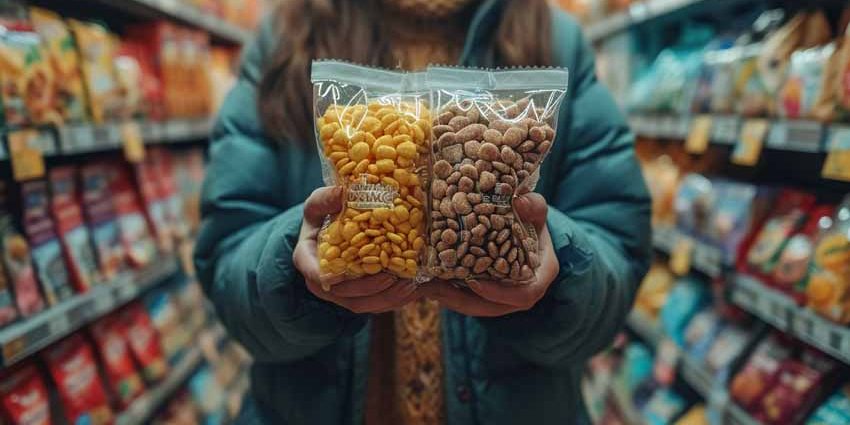Ecolabels are labelling schemes designed to communicate and market a product’s environmental credentials.
They are a valuable tool that can enable consumers to make more informed choices about the products they buy based on their environmental footprint, helping them to make choices that are more in line with their diet and values1.
There are currently more than 450 voluntary environmental labels in use worldwide, and at least 230 in Europe, including Marine Stewardship Council (MSC) and Rainforest Alliance.
The success story prior to environmental labels is that of nutrition labels, which research has shown can improve consumer decision-making, for example by making healthier food choices more obvious.
But labels alone do not have the power to drive the necessary changes in the population, as they are unlikely, for example, to motivate consumers to stop eating animal products or to choose the organic variety of a product when at the same time it is the most expensive option.
To have a positive impact, eco-labelling must therefore be part of a package of interventions, including increasing the availability of more sustainable options and public information campaigns on the need to make sustainable choices.
Studies suggest that there is broad support for an independent, universal and evidence-based logo for sustainable food products and for the responsibility of validating organic claims to be in the hands of an independent party. This is probably the best way to combat the flood of eco-labels and end greenwashing, and to empower consumers to make informed choices about the impact of their diet on the environment.
Here are some inights from the EIT Food TrustTracker 2023 study:
- There is a clear desire on the part of consumers to be better informed about the sustainability of food products. More than half of European consumers (56%) feel that they know too little about the sustainability of their food.
- Consumers who are already health and sustainability conscious show a greater desire to be better informed. 84% of consumers who almost always or often choose sustainable food would like to know more about the environmental credentials of the food they buy. This is much higher than the 39% of consumers who never or rarely choose sustainable food.
- The information currently available to consumers is insufficient. Consumers were asked how they would feel if a universal label were introduced, but one of the reasons why around a third (32%) of consumers would not use it was because “yet another label” would make it difficult for them to identify sustainable products. There is a relationship between level of education and the extent to which consumers perceive that they receive conflicting information. The higher the level of education, the more conflicts are experienced. Among those with a basic level of education (primary school), just under half (48%) report experiencing conflicting information, compared to 60% of those with a university degree and 62% of those with a post-doctoral degree.
- Labels are often not trusted. Trust is an important condition for labels to be effective. But consumers do not trust the integrity of environmental labels. Four out of ten consumers consider sustainability labels to be untrustworthy. Part of this lack of trust is due to the absence of provisions that allow consumers to validate the claims they see on labels. With this lack of trust, it is not surprising that almost two thirds find it difficult to understand the extent to which a given food product is sustainable (62%). Younger consumers, under 35, report fewer difficulties (55%) than those over 65.
- Even so, there is reliance on sustainability labels. Labels are important sustainability signals for consumers. Almost half of consumers (47%) say they currently use sustainability labels. This percentage is higher among consumers who already tend to make healthy and sustainable food choices (63% and 55% respectively). It is noteworthy that the higher the level of education, the more consumers look at sustainability labels; only a quarter (25%) of consumers with secondary education or less look at labels, compared to more than half (51%) of consumers with tertiary education. A similar proportion of consumers (46%) look at a product’s ingredient list, while 42% look at where a product is made to assess its sustainability credentials. Less than a fifth (18%) say they rely on their own knowledge to judge a product’s sustainability.
- Governments must work to improve their perception of trust. Less than half of European consumers (41%) believe that their government is able to validate and regulate sustainability certifications on food packaging.
- A European sustainability label would be welcome. A majority of European consumers (67%) say they are likely to use an international sustainability label when choosing food. Consumers can imagine themselves using an international sustainability label to be able to differentiate between different food categories, e.g. to decide whether to buy minced meat or buy lentils instead as a meat substitute (71%), and to understand the differences between different brands or types of products (e.g. using organic or free-range or conventional pork) (84%). An international label would therefore make it easier to compare food categories, food products and food brands, which so far is considered difficult.
The full report is available here: https://www.eitfood.eu/eco-labelling
